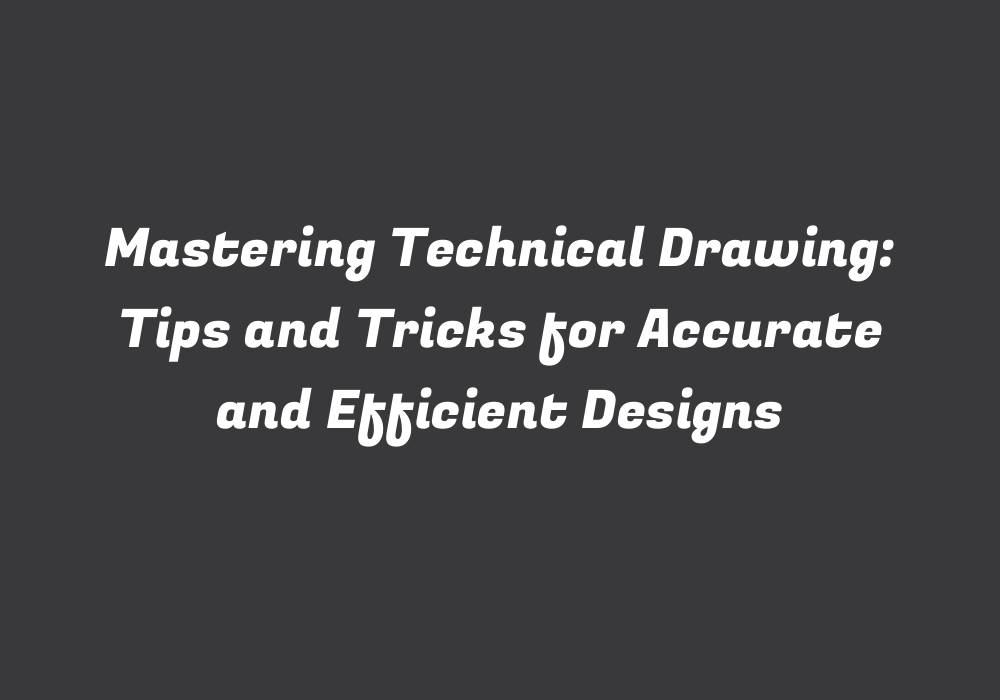Mastering Technical Drawing: Tips and Tricks for Accurate and Efficient Designs
Technical drawing is an essential skill in various industries, such as architecture, engineering, manufacturing, and product design. It allows the creator to visualize ideas, plan projects, communicate their vision to others, and even make precise adjustments while working on intricate designs. To master technical drawing, you need a combination of knowledge, practice, and a set of useful tips and tricks. In this article, we will delve into these strategies and techniques to help you enhance your skills in creating accurate and efficient designs.
1. Choose the Right Tools
The first step towards mastering technical drawing is having access to the right tools. You need a pen or pencil that creates smooth, dark lines for clarity. A drafting board with a T-square and triangle can help align your straight lines and create angles accurately. Additionally, you’ll want to invest in a set of high-quality erasers that are gentle enough not to smudge your drawing while still being able to remove mistakes effectively.
2. Master the Basics of Proportion and Symmetry
Understanding proportion is essential for technical drawing, as it helps you create realistic representations of objects in different scales. It also enables you to achieve a sense of balance and harmony within your designs. A good rule of thumb is to remember that larger elements should have more space between them than smaller ones. Practice by sketching various geometric shapes with varying sizes, ensuring that their proportions are accurate.
Symmetry is another aspect worth mastering for technical drawing. It allows you to create well-balanced designs and ensures that both sides of an object look similar. Use reference materials like photos or diagrams to learn about symmetry in real-world objects and apply the same principles when creating your drawings.
3. Practice Perspective Drawing
Perspective is one of the most challenging aspects of technical drawing, as it involves understanding how objects appear from different viewpoints. To master perspective, you need to develop a deep understanding of vanishing points and their relationship with the subject you are drawing.
Practice by drawing various objects and scenes from different angles and distances. It’s essential to observe the distortion that occurs in the size and shape of objects as they move away or closer. By studying these changes, you can create more realistic representations of the world around you in your technical drawings.
4. Focus on Accuracy in Dimensions
Accurate dimensions are crucial for successful technical drawings. Mistakes in sizing and measurements can lead to disastrous results, especially when creating complex designs that require precise adjustments. Always double-check your dimensions using measuring tools like rulers or scales to ensure accuracy.
One helpful technique is to create a template with common sizes, such as standard paper dimensions or typical object proportions. Using this guide can save you time and effort while maintaining consistency in your drawings.
5. Learn from Different Drawing Techniques
Technical drawing has many different methods that cater to various industries and applications. To master technical drawing, it’s essential to familiarize yourself with these techniques and choose the one that best suits your needs. Some popular techniques include:
– Orthographic projection: This is a standard method for creating technical drawings in engineering and architecture by showing multiple views of an object (front, top, side, and back).
– Isometric drawing: Used in product design, this technique creates three-dimensional representations from an angled perspective where all angles are at 30° or multiples thereof.
– Axonometric drawing: Also known as Oblique projection, this technique offers a more realistic representation of objects, with sloping planes and curved surfaces that resemble their actual appearance.
By learning different techniques and practicing them regularly, you can enhance your skills in technical drawing and adapt to various projects.
6. Improve Your Observation Skills
Observational skills play a significant role in technical drawing, allowing you to accurately depict the details of objects and scenes. Practice by taking detailed notes, sketching from life, or studying photographs for elements such as textures, shadows, and patterns. The more you observe and analyze, the better your ability to convey these intricacies in your drawings will become.
7. Seek Feedback and Continuous Improvement
As with any skill, mastering technical drawing requires dedication, practice, and a willingness to learn from both successes and failures. Share your work with peers, mentors, or professionals in the field for constructive feedback on how you can improve your designs and techniques. Use these insights as an opportunity to refine your skills and grow even further in mastering technical drawing.
Conclusion
Mastering technical drawing requires a combination of knowledge, practice, and patience. By choosing the right tools, understanding basic principles like proportion, perspective, accuracy, and observation, exploring various techniques, and seeking continuous improvement through feedback, you can elevate your skills in creating accurate and efficient designs. Embrace this journey and watch as your abilities grow in this essential aspect of design and engineering.
